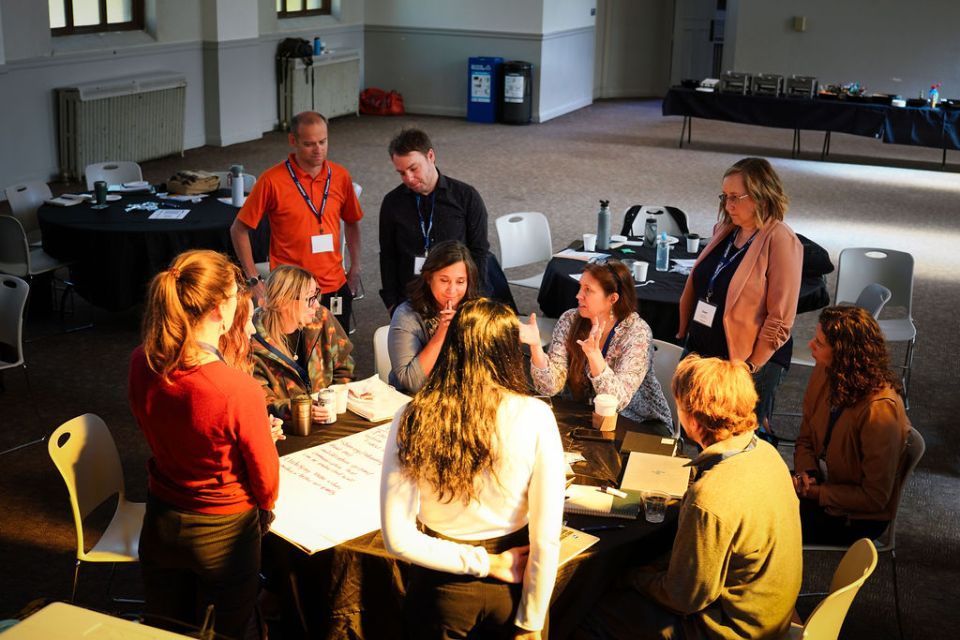In recent years, the Western U.S. has been roiled by wildfires, floods, drought, and extreme temperatures. Nowhere have climate risks been more top of mind than the Rocky Mountain region of the country.
Affordable housing developers, owners, and operators in this area face challenges ranging from the impact of drought on water supply, to the need for repairs due to high winds and other extreme weather conditions.
Over the course of eight weeks this fall, a cohort of 19 affordable housing owners and operators participated in the Rocky Mountain Resilience Academy. The academy worked with cohort members on a wide range of issues and solutions, including optimal ways to:
- Assess portfolio risk
- Implement resilience strategies
- Navigate funding opportunities
- Develop business continuity plans
- Explore decarbonization policies and programs
- Identify solutions to current insurance challenges facing the industry
The Rocky Mountain Resilience Academy would not have been possible without generous support from sponsors, including the JPMorgan Chase Foundation. The training marked Enterprise’s fifth Climate Resilience Academy after holding similar academies for the Southeast, Gulf Coast, New York/New Jersey, and West Coast regions. So far, more than 90 affordable housing owners and operators have participated, and the program is expected to expand to serve about 110 organizations.
Sharing Common Challenges

The Rocky Mountain Resilience Academy drew affordable housing owners and operators from Colorado, Utah, New Mexico, and Montana. During the kick-off, cohort members shared the wide range of climate risks and impacts that they have faced, from extreme low temperatures, high winds, the compounding impact of wildfires on droughts, and a stressed power grid infrastructure, to thousand-year flood events, a drying Great Salt Lake, dust storms, and unpredictable weather. When asked how these climate risks specifically affect housing developments, cohort members noted the increased energy burden and the damage caused by hail and high wind events.
Cohort members also shared their most common challenges related to developing and maintaining resilient housing. Some building challenges included the cost of HVAC upgrades in older buildings and constant leaks within properties. There were also harder-to-address issues such as broader infrastructure challenges of road, sewer, water, and power infrastructure, utilities underserving communities, and the impact of drought on wells.
Academy participants agreed on the importance of early, proactive planning to incorporate resilience. Many said they were reassured by the number of tools at their disposal: “There are a lot of resources out there to tap in to, so we don't have to figure everything out on our own.”
When asked about what others in the sector should know about climate resilience, Ashleigh Wheeler of the Denver Housing Authority said, “They should know how valuable this Academy is!”

Tackling Key Issues with the Right Tools
Beyond the technical and infrastructure issues that make developing resilient housing difficult, developers and tenants face a steep learning curve, cohort members said, noting the cost of retrofits, the general resistance to change, and resident communication challenges. They also expressed frustration with requirements to implement new technologies that may not be fully ready for market, especially due to the high repair costs for these technologies. Developers also mentioned the challenges they face around high insurance premiums and deductibles.
Through the academy and individual technical assistance sessions, cohort members raised issues around their specific properties and learned about tools to support resilience strategies, acquire funding, and prepare for natural disasters. Here are some common themes discussed during the academy and technical assistance sessions:
- Staff Capacity Limitations: Many affordable housing developers in our cohort did not have dedicated staff to complete resilience projects or even staff capacity to find funding for resilience projects. Resources available to help include hiring undergraduate or graduate student interns to quickly add staff capacity for fundraising and resilience upgrades. In addition, some federal funding sources, such as the EPA Community Change Grants, offer technical assistance support for grant applications.
- Support with Funding and Financing: Lack of funding and financing can create a significant barrier to completing resilience projects. Cohort members shared tactics such as partnering with local chambers of commerce, local foundations, healthcare providers, and 9% tax credit investors. In terms of marketing for potential funders, cohort members developed newsletters, engaged with local media, joined boards of other nonprofits, and kept their websites and social media up to date. Through the academy, we developed a resource on local, state, and federal funding sources available for climate resilience projects that cohort members can use moving forward.
- Prioritization of Implementation: Several cohort members stressed the importance of prioritizing implementation of resilience measures across portfolios. One potential solution to this issue: complete property risk assessments and seek support from organizations and consultants such as Energy Outreach Colorado or Group 14 Engineering. Another method: conduct resident surveys so property owners can understand the needs of tenants in relation to heating, cooling, and water.
- Electrification Mandates: Multiple Colorado-based organizations said they would like support complying with electrification mandates. The Colorado Housing and Finance Authority in collaboration with Enterprise and other partners have launched the Colorado Multifamily Affordable Housing Electrification Hub. The hub is a technical resource designed to help equip the multifamily affordable housing community in Colorado with electrification design and decisions through access to technical resources, peer learning, and financing and development resources.
Sharing Successes
Through the academy, cohort members are strengthening their existing resilience measures and incorporating new strategies in their properties. For example, two cohort members are working in partnership to develop workforce housing in Montana, while implementing resilience strategies to mitigate the risks of wildfire, flooding, and drought in the area. Other successes include:
- Advocacy to tie local funding to all-electric construction in Salt Lake City to reduce air pollution.
- Development of a draft carbon reduction plan by a Denver based organization with plans to integrate resilience measures.
Enterprise is planning additional resilience academies targeting the Midwest and Mid-Atlantic through 2024. Subscribe to our national newsletter to learn about these and other opportunities.



